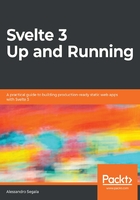
Chapter 1: Meet Svelte
When developers think of JavaScript frameworks, the options abound. Even within the narrow scope of front-end development that we're covering in this book, most developers will be familiar with (or have at least heard of) tools such as Angular, React, and Vue.
However, you picked up this book because you've heard of Svelte, and you've heard of it's growing in popularity. You've probably also heard that Svelte is different, and that there's something magical about it. I'm using the word magical on purpose: in fact, the original tagline for the Svelte project was "the magical disappearing UI framework."
This book is about the Svelte 3 front-end JavaScript framework, the last version as of the time of writing, which was released in April 2019.
You can use Svelte to build single, reusable components for projects of any kind, including larger applications written with Angular, React, Vue, or any other frameworks. Or, you can build entire web applications with it – just like we'll be doing in this book.
Among all the various frameworks, in most comparisons, Svelte 3 stands out for its ability to produce smaller code bundles that run faster in the browser, compared to Angular or React. This is a big part of what makes Svelte magical. But, perhaps even more importantly, developers largely enjoy working with Svelte 3; building components and applications with it feels to many very similar to using "vanilla JavaScript."
Throughout this book, I'll help you build your first, fully functional project with Svelte 3: a journaling app. We'll go from bootstrapping the development environment all the way to production with an automated continuous integration and delivery pipeline.
While building this sample app, we'll cover the majority of the features of Svelte 3. By the end, you should have a strong foundation to go and create your own apps with Svelte.
In this chapter, we'll cover the following topics:
- Modern web app development
- Why you should use Svelte
- Details on the app we'll be building